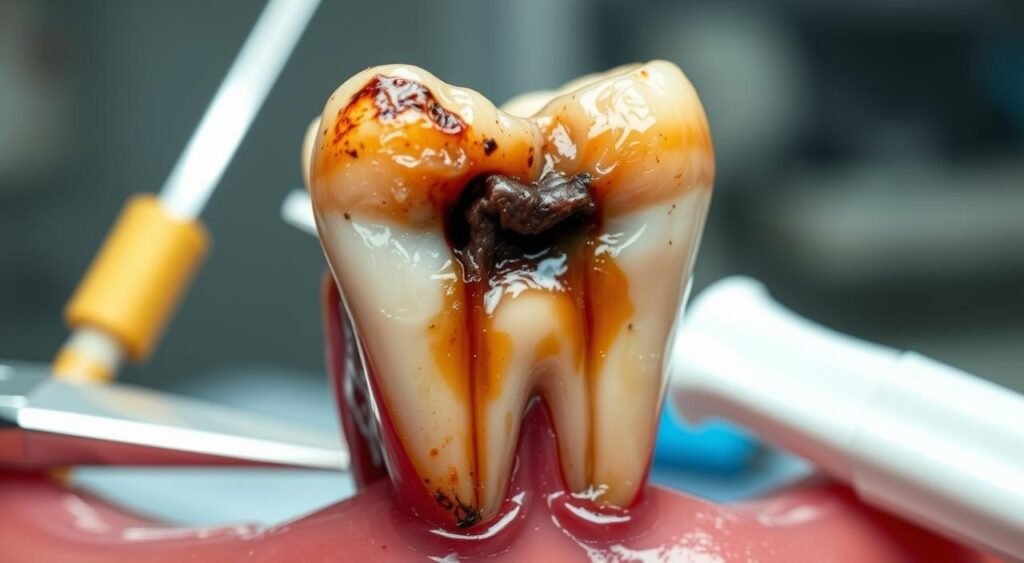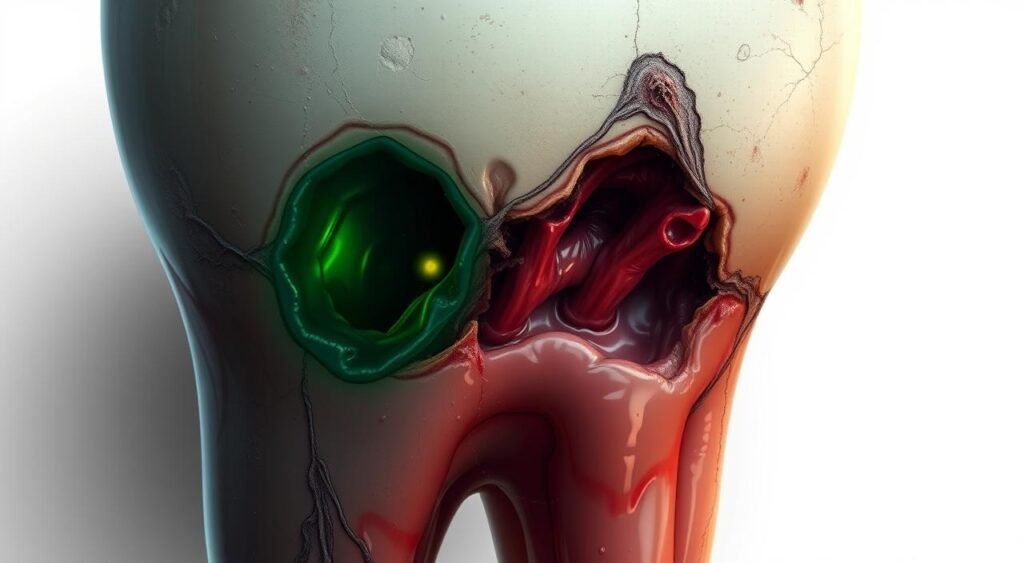As you sit in the dentist’s chair, your mouth throbs with unbearable pain, and you wonder, can a dentist pull an infected tooth? Yes, they can, but it’s not always straightforward. Tooth infections are painful, and knowing how to address them is crucial.
Dental experts can manage infected teeth, but the severity of the infection plays a big role. If the infection is deep or the tooth is significantly damaged, extraction may be the best option. This can relieve pain and prevent further complications.
- Tooth Infections and Dental Interventions
- Can a Dentist Pull an Infected Tooth?
- Identifying the Signs of a Tooth Infection
- Unpacking the Root Causes of Tooth Infections
- Exploring Alternatives to Tooth Extraction
- Factors Dentists Evaluate Before Extracting an Infected Tooth
- What to Expect After an Infected Tooth Is Pulled
- Conclusion
Tooth Infections and Dental Interventions
Tooth infections happen when harmful bacteria get inside a tooth. This can happen through a crack or chip. These bacteria can make a cavity that gets deeper over time.
When the cavity reaches the dentin and pulp, it’s a big problem. This is because it can harm the nerves and tissues inside the tooth. This is why it’s so important to take care of it quickly.
Sometimes, a dentist might wait before pulling out an infected tooth. This is to stop the infection from spreading to other teeth or gums. But in severe cases, removing the tooth might be the only option.
Before pulling out the tooth, the dentist might try to save it with root canal therapy. This is a way to clean out the infection and save the tooth. But it’s not always possible, and the decision depends on the infection’s severity.
| Treatment Option | Effectiveness | Considerations |
|---|---|---|
| Tooth Extraction | Highly effective in removing the infected tooth | May be necessary in cases of severe infection or when other options are not viable |
| Root Canal Therapy | Successful in saving the natural tooth structure in many cases | Requires multiple visits and may not be suitable for advanced infections |
| Antibiotic Treatment | Temporarily reduces infection and alleviates symptoms | Does not provide a permanent solution and may only be a short-term measure |
The choice between removing the tooth or trying other treatments depends on the infection’s severity and the patient’s health. Quick dental care is key to stop the infection from getting worse.

Can a Dentist Pull an Infected Tooth?
When you have an infected tooth, you might wonder if a dentist can remove it. Yes, dentists can take out an infected tooth. But, they usually drain the abscess or use antibiotics to lessen the infection first.
When Is Extraction Advisable?
Dentists might suggest removing a tooth if the infection is very bad and spreads. This stops the bacteria from infecting other mouth or body parts. If the abscess is high up on the gum and there’s no clear decay, they might treat the infection first and watch how it goes before deciding to extract the tooth.
Impact of Infection Severity on Tooth Extraction
The seriousness of the tooth infection affects the dentist’s choice. If it’s mild, antibiotics might be enough to heal it. But if it’s severe, with signs like swelling, fever, or trouble opening the mouth, the dentist might wait to extract the tooth until the infection is better.
Why Might Dentists Delay the Extraction?
Dentists might wait to remove an infected tooth if it’s very swollen. Taking out a tooth during a severe infection can cause more problems, like spreading the infection. By treating the infection with antibiotics or draining the abscess first, the dentist makes the extraction safer and more effective.

In summary, dentists can remove an infected tooth but often prefer to treat the infection first. This could mean using antibiotics or draining the abscess. This way, they prevent the infection from getting worse and make the extraction safer and more likely to be successful.
Identifying the Signs of a Tooth Infection
Spotting early signs of a tooth infection is key to stopping it. If you see an infection starting, call a dentist right away. This quick move can prevent the infection from getting worse and causing bigger problems.
Look out for signs like increased tooth sensitivity, pain around a tooth, and pain spreading to the jawbone, neck, or ear. You might also have a fever, a bad taste in your mouth, trouble chewing or biting, swollen cheeks and neck, swollen lymph nodes, bad breath, and pus from the affected area.
Don’t ignore these signs, as a tooth infection can get worse fast. Getting to the dentist quickly is crucial. They can diagnose and treat the problem, keeping your mouth healthy.
It’s important to act fast if you see signs of a tooth infection. This can stop it from causing more harm. By being alert and quick, you protect your oral health and avoid serious issues from a tooth infection.
Unpacking the Root Causes of Tooth Infections
Tooth infections are common and need to be understood to prevent and manage them. They start with harmful bacteria growing in the tooth or gums. A chip or crack in the tooth lets these bacteria inside, causing trouble.
The Role of Bacteria in Tooth Decay
Bacteria inside the tooth feed on sugars and starches from our food. This makes the tooth decay and erodes the enamel and dentin. Over time, this creates a cavity that gets deeper.
As the cavity gets worse, bacteria move towards the pulp. The pulp is the innermost part with nerves and tissues. This is a serious problem.
How Cavities Escalate to Infections
When bacteria reach the pulp, the infection gets worse. It may need a can a dentist pull an infected tooth or other treatments. If not treated, the infection can spread to the bone and gums, leading to serious issues.
Knowing how bacteria cause tooth decay and infections shows why do dentist pull infected tooth is important. Getting quick dental care is key to stopping these problems.
Exploring Alternatives to Tooth Extraction
When you have a severe tooth infection, your dentist will look for ways to avoid pulling the tooth. They might give you antibiotics to fight the infection in your gums. They could also drain the abscess in the office to clear out pus. After a few days of antibiotics, they’ll check the tooth and the abscess again.
Sometimes, antibiotics work and the infection goes away, so you don’t need to pull the tooth. But if the tooth is too damaged, you might have to choose between a root canal or pulling it. A root canal tries to save the tooth by removing the infected pulp. If the infection is too far gone or the tooth can’t be saved, pulling it is the only option.
Other ways to avoid pulling a tooth include:
- LANAP (Laser-Assisted New Attachment Procedure): This is a laser treatment that can help fix the area around a badly infected tooth, maybe saving it.
- Apicoectomy: This is when they remove the infected part at the end of the root, not the whole tooth, to clear the infection.
- Orthodontic treatments: If your teeth are crowded or not straight, your dentist might suggest pulling a tooth to make room for the others.
| Procedure | Description | Success Rate |
|---|---|---|
| LANAP | Minimally invasive laser treatment to regenerate supporting structures around a severely infected tooth | Requires intensive training, used in advanced cases to save a tooth |
| Apicoectomy | Removal of the infected root tip, rather than the entire tooth | Less invasive, usually only requiring local anesthesia |
| Orthodontic Treatment | Tooth extraction to create space for proper tooth alignment | Effective in addressing crowding and misalignment issues |
Your dentist will look at how bad your tooth infection is and try different options before suggesting pulling the tooth. By trying these methods, they can often save your natural tooth and keep your mouth healthy.
Factors Dentists Evaluate Before Extracting an Infected Tooth
Dentists must think carefully before deciding to pull an infected tooth. They look at the infection’s severity, the patient’s health, and the risks. These factors help decide the best action.
The Dilemma of Pulling an Abscessed Tooth
Swelling around the infected tooth is a big worry for dentists. If the face is very swollen, it’s hard to numb the area for the extraction. This swelling also makes it tough for the dentist to hold the tooth right, which could cause it to break off.
Role of X-rays in Assessing Tooth Health
X-rays are key for dentists to see how bad the infection is and what to do next. They show the infection’s size, the bone’s condition, and the tooth’s health. With this info, dentists can choose between pulling the tooth or trying root canal therapy.
Before pulling the tooth, dentists might give antibiotics to lessen the infection. They also consider the patient’s health, any medical conditions, and their dentist’s schedule. This helps decide when to pull the tooth.
Deciding to pull an infected tooth is a careful process. Dentists look at many factors to keep their patients safe and healthy.
What to Expect After an Infected Tooth Is Pulled
When a dentist pulls an infected tooth, they first focus on stopping the bleeding. This lets a clot form in the socket. This clot is key to avoid dry socket, a painful condition. Dry socket happens when the clot gets knocked out, showing the bone and nerves.
Your dentist will tell you to bite on gauze to help stop the bleeding.
Immediate Aftercare Instructions
Your dentist will give you specific advice for the first few days. This includes:
- Avoiding hard, crunchy, or hot foods that could irritate the extraction site
- Applying ice packs to the outside of your jaw to reduce swelling and discomfort
- Taking over-the-counter pain medication as needed to manage any discomfort
- Gently rinsing your mouth with saltwater solution to keep the area clean
- Not smoking or using straws, as the suction can dislodge the clot
Following these steps helps with healing and avoids problems like dry socket or infection.
Long-term Healing and Maintenance
After the initial healing, focus on long-term dental health to avoid infections. This means:
- Practicing excellent oral hygiene through regular brushing and flossing
- Scheduling routine dental check-ups and cleanings every six months
- Promptly addressing any new dental issues, such as cavities or gum disease
By doing these things, you can help ensure a smooth recovery. It also lowers the chance of needing another tooth extraction later.
Conclusion
Dentists can pull an infected tooth, but they look at how bad the infection is first. They might use antibiotics or other treatments before taking out the tooth. They think about how bad the infection is, if it could spread, and your overall health.
If you have a tooth infection, you should see your dentist right away. Not treating it can lead to serious problems, like the infection spreading and causing health issues. Your dentist will decide the best way to help you, like with antibiotics, a root canal, or removing the tooth.
Your dentist wants to fix your dental infection and stop more problems. It’s important to talk openly with your dentist to get the right treatment. This way, you can decide together if removing the tooth is needed or if there are other options. Working together, you can fix the issue and keep your mouth healthy.
FAQ – Infected Tooth Extraction
Can a dentist pull an infected tooth?
Yes, dentists can pull an infected tooth, but it depends on the infection’s severity. They might first try to treat the infection with antibiotics or draining the abscess before extraction.
Will a dentist pull an infected tooth same day?
The dentist might not pull an abscessed tooth right away. They’ll check if the abscess is high up the gum line and if there’s no decay under the gums in an X-ray. If the infection looks like it’s getting better, they’ll wait a few days before deciding to extract the tooth.
Can you die from pulling an infected tooth?
Severe tooth infections can be dangerous, but dying from pulling an infected tooth is rare. Dentists take steps to prevent infection spread and ensure healing after the extraction.
Will a dentist pull an infected tooth if your face is swollen?
No, dentists won’t extract an infected tooth if your face is swollen. If the infection is severe, swelling around the tooth makes it hard to give anesthesia or remove the tooth safely.
Can a dentist remove a tooth while aching?
Yes, dentists can remove a tooth that hurts from an infection. They’ll usually treat the infection with antibiotics or draining the abscess first. This helps reduce pain and complications.
Can you pull an infected tooth at home?
No, don’t try to pull an infected tooth by yourself. Doing so can cause more problems, like the tooth breaking or the infection getting worse. Always get professional dental care to safely remove an infected tooth.
How to get rid of a tooth abscess without going to the dentist?
The best way to deal with a tooth abscess is to see a dentist. Home remedies might help for a bit, but they won’t fix the infection. Dentists can drain the abscess, treat the infection with antibiotics, and remove it properly.
Will pulling an infected tooth stop the pain?
Pulling an infected tooth can help with the pain, but it might not work right away. The dentist will treat the infection first, maybe by draining the abscess or antibiotics. Then, they can safely remove the tooth once the pain and swelling are controlled.
Do dentists pull infected teeth?
Yes, dentists can and do remove infected teeth. They usually try to treat the infection first, like draining the abscess or antibiotics, before extraction. The decision to remove an infected tooth depends on how severe the infection is.








